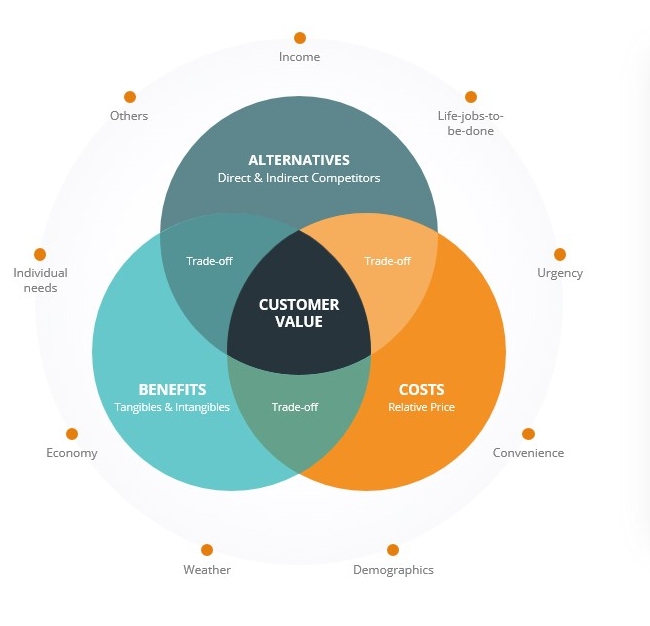Welcome to the Customer Value Glossary!
This article will deepen your understanding of what customer value is, how it relates to customer decisions, and the technology being used to best measure it.
Customer Value has existed for over 30 years, and it is the common ground that all departments can share as an overarching strategic measurement.
The rate at which we can gather and process the necessary qualitative and quantitative insights has skyrocketed with modern research tools like Natural Language Processing AI – just the soil that Customer Value needed to take root.
Jump to a Category – Customer Value Glossary
Customer Value
Customer Value (CV)
Customer value is the assessment of tradeoffs in customers’ minds that leads to a conclusion of perceived value. At Worthix, we also call this the “worth it” conclusion.
For any purchase decision, customers will consider cost, benefits, and market alternatives. Customer Value is the ultimate factor that drives loyalty and expenditure. Different customer profiles value different things.
*See External Factors, Customer Value Trade-offs, Cost, Benefits, Alternatives
Customer Value Trade-offs
When assessing the value or worth of a product or service, customers weigh out trade-offs prior to making decisions of expenditure. These are:
- Cost – Relative Price
- Benefits – Tangible and Intangible
- Alternatives – Direct and indirect competitors, substitutes
*See Cost, Benefits, Alternatives

Cost – Relative Price
Cost is the currency that customers exchange for benefits. It is best to track ‘relative’ price as opposed to ‘absolute’ price.
Relative price is always the price when compared to another product or service with similar or equal benefits.
*See Customer Value Trade-offs, Benefits, Alternatives
Benefits – Tangible and Intangible
Benefits are what you receive in exchange for a cost. They can be tangible or intangible.
- Tangible or functional benefits are those that are easy to explain because they have a concrete component to them. These drivers tend to deliver the most valuable insights into how the operations of the business affect customers’ perception of worth, for example, speed, quality, price, customer service, location, or cleanliness of a store.
- Intangible or emotional benefits are not easy to explain because they are abstract. These elements are notoriously hard to measure at scale and are usually researched and mapped out qualitatively with focus groups or in-depth interviews.
These drivers tend to have a greater impact on the Marketing, Communications, and Branding departments. There are 2 main intangible benefits: social proof and brand identification.
*See Social Proof, Brand Identification, Customer Value Trade-offs, Costs, Alternatives
Social Proof
In Robert Cialdini’s “Influence”, he proposes that our purchase decisions are often shaped by the perception that others have of us.
This phenomenon known as social proof has deeply influenced the way certain brands market their products and services. How our friends, family, and society will perceive and judge us based on our purchases has a strong impact on our decision to buy any product or service.
There are several questions you may ask to understand the impact of social proof on a certain purchase decision such as ‘Do you think your friends and family would like buying X or shopping at X?’ or ‘Would you recommend X brand to your friends and family?’, this is also known as Net Promote Score (NPS) or recommendation metrics.
Brand Identification
The biggest brands in the world have carefully crafted their brands so that they reflect the personality and identity that their customers will find appealing or aspiring.
Brands are depicted as people, emotions, beliefs, values, and ideals, to connect on a deep and emotional level with their customers. When executed properly, not only are brands influenced by their customers, but they also influence their customers’ personalities and identification in return.
Asking your customers to describe your brands’ customers is a way to allow them to project themselves and tell you more about the characteristics that your customers have.
Another common exercise is to ask customers to describe the brand as if it was a person, this will reveal the accuracy of the brand’s execution when pursuing a certain personality or values.
*See Benefits, Social Proof
Alternatives
Customers always consider other available options prior to making a choice. ‘Alternatives’ refers to all the players in the market that could affect customers’ perception of the value of the products or services offered by a company.
- Direct competitors offer the same solution to the same problem.
- Indirect competitors offer a different solution to the same problem.
- Substitutes are solutions that have not previously been used to solve that problem.
*See Customer Value Trade-offs, Costs, Benefits
Customer Value Alignment
Customer Value Alignment (CVA) is the process of closing the gap between the value customers perceive and the value your company delivers. This process is continuous, since customers’ needs, wants, and expectations are always changing.
*See Customer Value Alignment Cycle, Customer Value SWOT, SWOT Analysis
Customer Value Alignment Cycle
Worthix’s Customer Value Alignment Cycle is the 3-step process of aligning your organization with the value your customers expect.
It is used to continuously track perceived and unmet customer value among all the experiences a company delivers, allowing companies to keep their strategies, product innovations, and day-to-day operations aligned to what drives customers’ decisions of expenditure and loyalty.
- Step 1: Track value. Our conversational AI continuously tracks Customer Value through short (2-minute) but in-depth 1-1 conversations at scale. Then, it classifies and ranks the most relevant topics according to their impact on your business.
- Step 2: Find actionability. Worthix looks for correlations between the conversation topics and your customers’ metadata such as the amount spent, payment method, product category, demographics, journey moment, etc, to find where, and when you should act to deliver the right customer value to the right customer segments.
- Step 3: Co-create innovation. Join Worthix’s conversations and tell it which customer perceptions should trigger additional questions and invite your customers to co-create solutions before you invest money and resources.
Finally, implement and Repeat.
With the Customer Value Alignment Cycle, you can continuously run controlled tests and, after implementing changes, monitor if your initiatives are creating the expected value.
*See Customer Value, Customer Value SWOT

Worthix (short for Worth Index)
Worthix (short for Worth Index)
The Worth Index is a metric that measures the perceived value of a product or service. It is calculated by collecting consumer data and analyzing it to determine how “worth it” a brand or business is to its customer base.
The name comes from the final question we ask ourselves before every buying decision, “Is it worth it?” We also call this the “worth it conclusion”.
When something is the most “worth it” alternative, it means the customer has already agreed to pay the perceived costs to have access to the expected emotional and rational benefits.
Therefore, knowing if your business is the most “worth it” alternative to your customers, is more important than knowing how satisfied they are or whether they will recommend your business.
Customer Value SWOT
The Customer Value SWOT is conducted within the same conceptual framework as a normal SWOT (Strengths, Weaknesses, Opportunities, Threats), analyzing internal and external factors that have an impact on a company’s performance.
The key difference is that it is purely based on the Voice of Customer feedback.
This removes or greatly reduces the risks of internal biases stemming from subjectivity, personal/organizational bias, and human interpretation.
*See Voice of Customer (VoC), SWOT Analysis, Qualitative
External Factors
A customer’s perceived value is influenced by external factors that could be difficult or impossible for businesses to change.
Companies have little to no control over these external factors, such as climate, socio-economic issues, politics, pandemics, or market innovation and disruption.
But while they cannot control these external factors, they can track how they influence customers’ perception of value.
This creates an opportunity to add incremental innovation that keeps companies safe from disruption and able to remain aligned with customer value.
*See Customer Value
Internal Factors
The internal factors that affect customers’ perceived value. These are levers within businesses’ control and can be summarized by the Marketing Mix (the 5 Ps of Marketing) below.
Marketing Mix (the 5 Ps of Marketing)
Product, Price, Promotion, Place, and People – are used to position a business strategically by satisfying customers and differentiating from competitors.
They have been used in business since the 1940’s.
- Product – The product/service itself; how it’s made, of what materials, and with what features.
- Price – The price paid by customers in order to get the product/service delivered.
- Place – Every point of sale that creates an experience for customers; in-store, online, distribution channels.
- Promotion – Brands’ communication: what they say, when, how, and to whom. It includes the message, the channel, and the audience.
- People – How people in the company treat customers and the resulting impact on customers’ experience with the brand.
Perceived Value
The perceived value is a customer’s opinion or evaluation of a product or service that can be affected by subjective or objective comparisons.
Unperceived Value
Unperceived value is any part of your offering that the customer either does not or cannot perceive as value and therefore has no impact on their perception(s) of value.
Artificial Intelligence (AI)
The theory and development of computer systems that can perform or mimic tasks that normally require human intelligence, such as visual perception, speech recognition, decision-making, and translation between languages.
In a business setting, AI systems are frequently used to automate routine tasks, freeing human agents to handle more complex interpersonal tasks.
Webinar: Empathetic Artificial Intelligence in VoC
Machine Learning (ML)
Machine learning is a sub-field of artificial intelligence (AI) that provides systems with the ability to automatically learn and improve from experience without being explicitly programmed.
Software as a Service (SaaS)
A business model that delivers and/or licenses software that is accessed over the internet via the browser or an application, without installation.
Typically operates through a recurring revenue model, where services or applications are paid for periodically.
Market Research and Industry Terminology
Customer-Centric Organization
A company whose culture focuses on effortlessly and seamlessly fulfilling customers’ needs, meeting their expectations, and delivering customer value.
All individuals in the organization are aware of the direct and indirect impact that their work has on the overall customer experience at every touchpoint.
Voice of Customer (VoC)
Any customer feedback that is captured through various channels and can be used to determine customer expectations, preferences, and aversions.
Listen to Season 9 of the Voices of CX Podcast
Customer Experience (CX)
Customer Experience is everything perceived, felt, and remembered by a customer, empathetically related to both their social reality and personal (or professional) needs before, during, and after a purchase.
Customer Journey
The path the customer takes, from the moment the need arises to beyond the moment it’s fulfilled.
Your customer journey is designed so the company can manage the customer experience at all available opportunities of interaction.
Touchpoints
Any part of a customer journey or customer experience where the brand interacts with or influences the customer in any way.
This covers any brand communications, direct and indirect interactions, as well as any considerations the customer makes with the brand in mind.
Qualitative Approach
An approach to measuring experiences and expectations by observing non-numeric information, such as human actions, reactions, thoughts, perceptions, and behaviors. In most cases, this information is found through interviews and focus groups.
Quantitative Approach
An approach to measuring experiences and expectations by observing numerical information, usually found through statistics, mathematics, and computations.
A common methodology used to find qualitative insights are surveys, which can measure the size or volume of the targeted population or sample that behaves or thinks in a certain way.
Net Promoter Score® (NPS)
A survey metric to measure customer word-of-mouth potential.
Created by Fred Reicheld and Bain & Company, NPS asks customers how likely they are to recommend a company to a friend and then lumps them into one of three categories: promoters, passives, and detractors.
The Net Promoter System and Net Promoter Score are registered trademarks of Bain & Co. Inc., Fred Reichheld and Satmetrix Systems, Inc.
Customer Satisfaction (CSAT)
A simplistic survey metric that is used to assess whether a customer is satisfied or not.
Defined as “the number of customers, or percentage of total customers, whose reported experience with a firm, its products, or its services (ratings) exceeds specified satisfaction goals.”
Customer Survey
A questionnaire that companies use to poll customers and get organized feedback. When these surveys are developed internally, they risk being invalidated by preconceived, unconscious biases that originate from the company’s particular point of view.
To avoid skewing survey data, it is almost always better to outsource the development and administration of surveys to a third party.
Segmentation
Market segmentation is the process of dividing a market of potential customers into groups, or segments, based on distinct characteristics.
The segments created are composed of consumers who will respond similarly to marketing strategies and who share traits such as similar interests, needs, or locations.
These segments can be used to create buyer personas, which are a helpful aide for both sales and marketing teams.
Innovation
Innovation is a new way of delivering customer value that no other company has introduced. It can take many forms, including but not limited to: new technology, new processes, new materials, or a new way of delivering an existing value proposition.
Value Proposition
Any innovation, service, or feature provided by a company to make them more attractive to customers. Customers must consider if a company’s value proposition is worth it to them before making a purchase decision.





